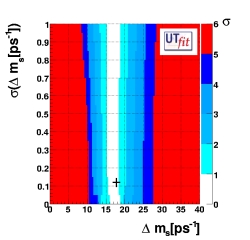 (EPS)
[JPG]
(EPS)
[JPG]
|
sin2β from B0 → J/ψ K0
Since at present the experimental uncertainty on the direct measurement of sin2β (using
time dependent CP asymmetry in b → cc
s decays) has been reduced to 0.026 and the theoretical error has been evaluated to be 0.012,
the study of this parameter is the most suitable for a significant test of the SM.
The cross in the plot shows the HFAG average for sin2β from B0 →
J/ψ K0, combined with the theoretical error.
The current direct measurement is not fully compatible with the SM prediction because of
the large value of Vub from inclusive measurement.
|
 (EPS)
[JPG]
(EPS)
[JPG]
|
Vub from inclusive and exclusive measurements
The present value of sin2β favours a value of Vub more compatible with the
exclusive determination than with the inclusive one.
The exclusive determination is still limited by the precision of the
determination of the B → π form factor from LQCD .
The inclusive measurement has a smaller error and a larger central value,
marginally compatible with the World Average of sin2β. In the plot we compare
the indirect determination from the other constraints to the experimental
measurements from exclusive (+) and inclusive (*) decays.
|

(EPS)
[JPG]
|
γ
The plot shows that the comparison of indirect determination obtained from the fit and the
direct determination, obtained combining all the experimental informations.
To obtain a value in the 3σ region, a sizable shift in the experimental measurement is
needed. This fact provides the most important evidence of the success of the Standard Model, after
the first measurement of sin 2β.
|

(EPS)
[JPG]
|
α
The situation for α is similar to the case of γ, with the additional complication that
the experimental measurement comes from an SU(2) analysis of several channels, introducing
a theoretical uncertainty on top of the experimental one.
Moreover, a channel dependent ambiguity in the determination of the angle is intrinsic in the method.
|

(EPS)
[JPG]
|
Δms
The new measurement of Δms can be compared to the prediction from
rest of the fit. The two values are in very good agreement.
The effectiveness of the comparison is limited by the precision on the theoretical
inputs, inducing a big error (compared to the experimental one) on the prediction
from the rest of the fit.
|
 (EPS)
[JPG]
(EPS)
[JPG]



